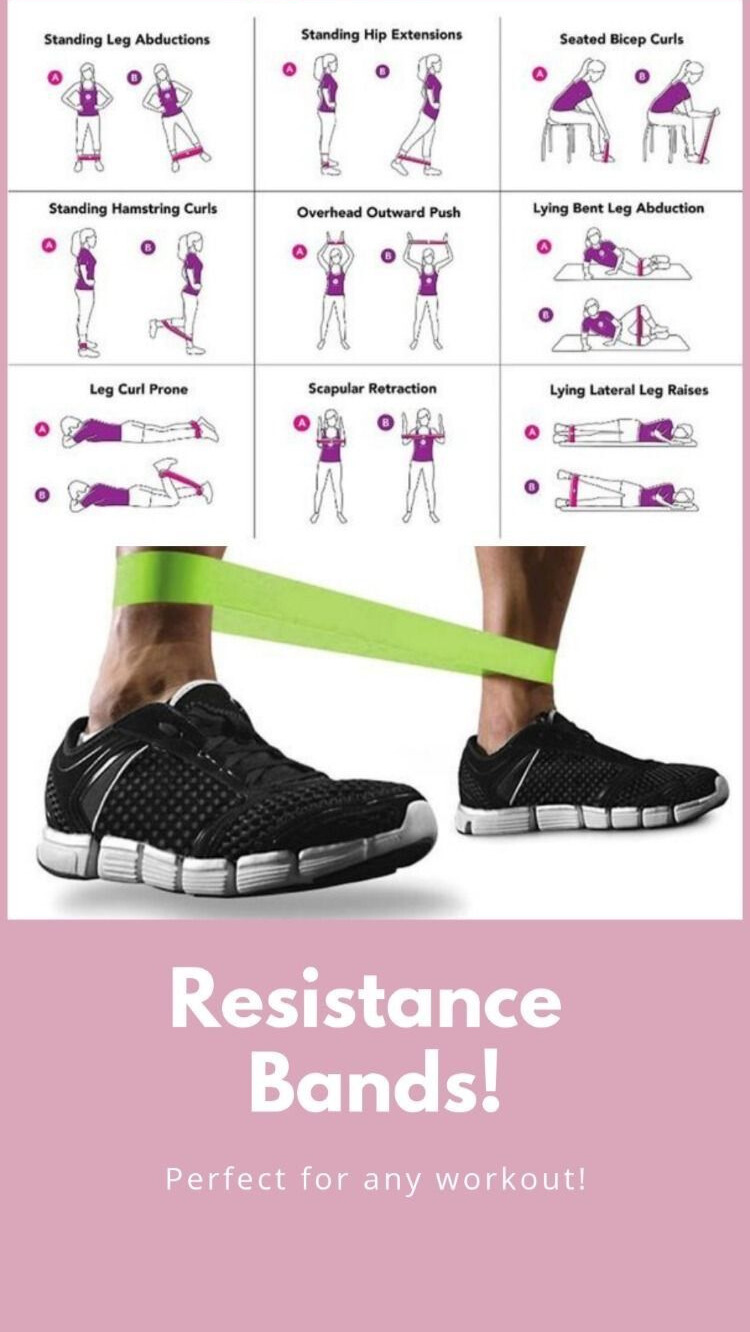Resistance Bands: The Perfect Addition to Any Workout
Resistance bands have become a staple in fitness routines worldwide, and for good reason. These versatile, portable, and affordable tools offer a wide range of benefits that can enhance any workout, whether you’re a beginner or a seasoned athlete. In this comprehensive guide, we’ll explore the numerous benefits of resistance bands, why they are perfect for any workout, and when you can use them to maximize your fitness results.
What Are Resistance Bands?
Resistance bands are elastic bands made from rubber or latex that come in various shapes, sizes, and resistance levels. They are used to add resistance to exercises, making them more challenging and effective. Resistance bands can be used for strength training, flexibility, rehabilitation, and more.
Benefits of Resistance Bands
1. Versatility
Resistance bands can be used for a wide variety of exercises, targeting different muscle groups. Whether you’re looking to strengthen your arms, legs, core, or back, resistance bands can be incorporated into your routine to provide a full-body workout.
2. Portability
One of the biggest advantages of resistance bands is their portability. They are lightweight and easy to carry, making them perfect for home workouts, travel, or even office exercises. You can easily slip them into your gym bag or suitcase and have a complete workout tool at your disposal wherever you go.
3. Affordability
Compared to other fitness equipment like dumbbells, kettlebells, or gym machines, resistance bands are relatively inexpensive. They offer a cost-effective way to add resistance to your workouts without breaking the bank.
4. Adjustable Resistance
Resistance bands come in different levels of resistance, from light to heavy. This allows you to gradually increase the intensity of your workouts as you build strength. You can also combine multiple bands to create even more resistance.
5. Joint-Friendly
Resistance bands provide a low-impact form of resistance that is easier on your joints compared to free weights. This makes them an excellent choice for individuals with joint issues or those recovering from injuries.
6. Improves Flexibility and Mobility
In addition to strength training, resistance bands can be used to improve flexibility and mobility. They are great for stretching exercises that can help increase your range of motion and reduce muscle stiffness.
7. Enhances Muscle Activation
Resistance bands create constant tension throughout the entire range of motion, which helps to activate more muscle fibers. This can lead to better muscle engagement and more effective workouts.
8. Suitable for All Fitness Levels
Whether you’re a beginner or an advanced athlete, resistance bands can be adapted to suit your fitness level. They are easy to use and can be incorporated into a wide range of exercises to match your strength and ability.
Why Resistance Bands Are Perfect for Any Workout
1. Full-Body Workouts
Resistance bands can be used to target every major muscle group in your body. From squats and lunges to bicep curls and shoulder presses, you can create a comprehensive workout routine that covers all aspects of fitness.
2. Complement Other Workout Equipment
Resistance bands can be used in conjunction with other workout equipment like dumbbells, barbells, and kettlebells to add variety and increase the intensity of your exercises. They can also be used to modify traditional exercises, making them more challenging or easier depending on your needs.
3. Ideal for Home Workouts
With the rise of home fitness, resistance bands have become a popular choice for those who prefer to work out at home. They take up minimal space and can be used in a variety of exercises, making them perfect for small living spaces.
4. Great for Rehabilitation
Resistance bands are often used in physical therapy and rehabilitation programs to help individuals recover from injuries. They provide a safe and effective way to rebuild strength and mobility without putting too much strain on the body.
5. Enhances Functional Fitness
Functional fitness focuses on exercises that mimic everyday movements, helping to improve your overall strength and mobility. Resistance bands are ideal for functional fitness exercises, as they allow you to perform movements that are similar to real-life activities.
When to Use Resistance Bands
1. Warm-Up and Cool-Down
Resistance bands can be used during your warm-up to activate your muscles and prepare your body for exercise. They can also be used during your cool-down to stretch and relax your muscles after a workout.
2. Strength Training
Incorporate resistance bands into your strength training routine to add resistance to exercises like squats, lunges, chest presses, and rows. They can help you build muscle and increase strength over time.
3. Flexibility and Mobility Work
Use resistance bands for stretching exercises to improve your flexibility and mobility. They can help you achieve a deeper stretch and increase your range of motion.
4. Rehabilitation
If you’re recovering from an injury, resistance bands can be used to gently strengthen and stretch the affected muscles. They provide a safe and effective way to rebuild strength and mobility without putting too much strain on your body.
5. Travel Workouts
When you’re on the go, resistance bands are a convenient way to stay active. They can be used in hotel rooms, parks, or any other location where you have a bit of space to move.
6. Group Fitness Classes
Resistance bands are often used in group fitness classes like yoga, Pilates, and boot camps. They add an extra challenge to traditional exercises and can be used to modify movements for different fitness levels.
Specific Exercises with Resistance Bands
1. Standing Leg Abductions
How to do it:
- Place the resistance band around your ankles.
- Stand with your feet hip-width apart.
- Lift one leg out to the side, keeping it straight.
- Slowly lower it back to the starting position.
- Repeat on the other side.
Benefits: This exercise targets the outer thighs and glutes, helping to tone and strengthen these areas.
2. Standing Hip Extensions
How to do it:
- Place the resistance band around your ankles.
- Stand with your feet hip-width apart.
- Lift one leg straight back, keeping it extended.
- Slowly lower it back to the starting position.
- Repeat on the other side.
Benefits: This exercise strengthens the glutes and hamstrings, improving lower body strength and stability.
3. Seated Bicep Curls
How to do it:
- Sit on a chair with the resistance band under your feet.
- Hold the ends of the band with your hands.
- Curl your hands towards your shoulders, keeping your elbows close to your body.
- Slowly lower your hands back to the starting position.
Benefits: This exercise targets the biceps, helping to build arm strength and definition.
4. Standing Hamstring Curls
How to do it:
- Place the resistance band around your ankles.
- Stand with your feet hip-width apart.
- Bend one knee, bringing your heel towards your glutes.
- Slowly lower it back to the starting position.
- Repeat on the other side.
Benefits: This exercise strengthens the hamstrings and glutes, improving lower body strength and flexibility.
5. Overhead Outward Push
How to do it:
- Hold the resistance band with both hands overhead.
- Push your hands outward, stretching the band.
- Slowly bring your hands back together.
Benefits: This exercise targets the shoulders and upper back, helping to improve upper body strength and posture.
6. Lying Bent Leg Abduction
How to do it:
- Lie on your side with the resistance band around your thighs.
- Bend your knees and lift your top leg, keeping your feet together.
- Slowly lower it back to the starting position.
- Repeat on the other side.
Benefits: This exercise targets the outer thighs and glutes, helping to tone and strengthen these areas.
7. Leg Curl Prone
How to do it:
- Lie on your stomach with the resistance band around your ankles.
- Bend one knee, bringing your heel towards your glutes.
- Slowly lower it back to the starting position.
- Repeat on the other side.
Benefits: This exercise strengthens the hamstrings and glutes, improving lower body strength and flexibility.
8. Scapular Retraction
How to do it:
- Hold the resistance band with both hands in front of you.
- Pull the band apart, squeezing your shoulder blades together.
- Slowly return to the starting position.
Benefits: This exercise targets the upper back and shoulders, helping to improve posture and upper body strength.
9. Lying Lateral Leg Raises
How to do it:
- Lie on your side with the resistance band around your thighs.
- Lift your top leg straight up, keeping it extended.
- Slowly lower it back to the starting position.
- Repeat on the other side.
Benefits: This exercise targets the outer thighs and glutes, helping to tone and strengthen these areas.
Tips for Maximizing Your Workout with Resistance Bands
1. Start with Light Resistance
If you’re new to resistance bands, start with a lighter resistance and gradually increase as you build strength.
2. Focus on Form
Proper form is crucial to prevent injury and maximize the effectiveness of your exercises. Take your time to learn the correct form for each exercise.
3. Incorporate Variety
Mix and match different exercises to keep your workouts interesting and target various muscle groups.
4. Combine with Other Workouts
Resistance bands can be used in conjunction with other workout equipment like dumbbells, kettlebells, and bodyweight exercises to create a comprehensive fitness routine.
5. Stay Consistent
Consistency is key to seeing results. Aim to incorporate resistance band exercises into your routine at least 3-4 times a week.
Conclusion
Resistance bands are a versatile, portable, and affordable fitness tool that can enhance any workout. Whether you’re looking to build strength, improve flexibility, or recover from an injury, resistance bands offer a wide range of benefits that make them perfect for any fitness routine. By incorporating resistance bands into your workouts, you can achieve better results and enjoy a more varied and effective exercise regimen.










